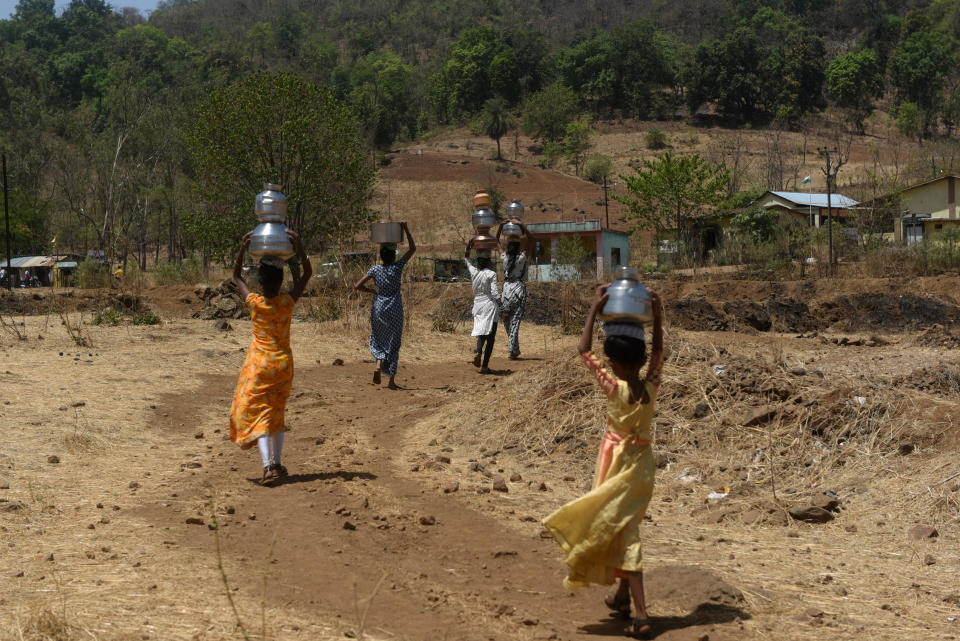New Delhi — It’s still spring, but hundreds of millions of people in South and Southeast Asia have already faced scorching temperatures. The summer heat arrived early, setting records and even claiming lives, and is expected to get much worse in May and June when summer truly begins.
By early May, strong heat waves were already responsible for nearly three dozen deaths across the vast region. Schools were forced to close weeks before the summer holidays and huge areas of new crops withered on barren farmland.
Where the most dangerous heat is expected in the US this summer
Scientists warn of far-reaching impacts in some of the world’s most densely populated regions and call on governments to take immediate action to prepare for the impact of climate change and do everything possible to mitigate human-caused global warming.
What is happening and where?
Several parts of India recorded maximum temperatures above 110 degrees Fahrenheit last month. On April 21, people in the eastern town of Bhagdora suffocated when the mercury reached 114.8 degrees.
The India Meteorological Department (IMD) on Tuesday issued a “red alert” warning for the eastern and southern states of Andhra Pradesh, Bihar, West Bengal and Odisha, where temperatures have been rising since mid-April. The IMD has warned that the heat wave is likely to get worse before it gets better.

At least two people died in the southern state of Kerala from suspected heatstroke over the weekend. Two other deaths were attributed to heat in the eastern state of Odisha in early April.
Scorching temperatures are hitting India right in the middle of a general elections in six weeks — in which nearly a billion people can vote — making campaigning and voting a challenge.
Authorities in neighboring Bangladesh have been forced to close all schools twice in the past two weeks amid the heat wave, and temperatures rose to nearly 110 degrees on Monday.
Several areas in Myanmar recorded record high temperatures of around 115 degrees, with a much higher heat index. The heat index is a measure of what the temperature actually is. feelings such as, taking into account humidity, wind speed and other factors.
Heatwave conditions have also been brutal in Southeast Asia. In the Philippines, authorities closed thousands of schools as vast areas of the country experienced drought and temperatures that reached 111 degrees – unprecedented in the region in early April.


In Thailand, authorities have urged people to stay at home whenever possible, with 30 deaths already attributed to heatstroke this year. In the capital Bangkok, authorities said the heat index on Thursday was an “extremely dangerous” 125.6 degrees.
In Vietnam, where temperatures surpassed 111 degrees, the national meteorological agency warned of the risk of forest fires, dehydration and heatstroke.
“Thousands of records are being brutalized across Asia, which is by far the most extreme event in global climate history,” he said. time historian Maximiliano Herrera said in a social media post last week.
What is causing the extreme heat?
Scientists are divided over the impact of the El Niño climate phenomenon, but many believe that the temporary warming of the central Pacific, which has altered weather patterns around the world for years, has made things much worse this summer in South and Southeast Asia.
“I think it’s a mix of El Niño, global warming and seasonality,” Professor Raghu Murtugudde, a climate scientist at the Indian Institute of Technology Mumbai, told CBS News. “El Niño is transitioning to La Niña. This is the time when maximum warming occurs towards the Indian Ocean. So all these things are basically adding steroids to the climate.”
But not all climate scientists agree.
“We saw heat waves last year and it wasn’t El Niño’s fault,” Professor Krishna AchutaRao, a scientist at the Center for Atmospheric Sciences at the Indian Institute of Technology, Delhi, told CBS News.
Last year, strong heat waves killed more than 100 people only in India and Pakistan, in April and May, again destroying crops and affecting millions of people.
“Like this year, last year the heat wave extended from parts of India to Bangladesh and Myanmar, and even Thailand. This year it went further east, to the Philippines. So it’s the same pattern,” he said AchutaRao. “I personally don’t believe El Niño is the cause.”
Most experts agree, however, that climate change is one of the main causes of the brutal heat hitting Asia this spring, and scientists said last year that climate change was making heat waves 100 times more likely to occur.
AchutaRao, along with other scientists working on the World Climate Attribution organization, compiled and analyzed data on last year’s heatwaves in the region and the dozens of natural disasters that accompanied them in Laos and Thailand. The team “concluded that [extreme weather] Events like these would not be possible without climate change.”
“Climate change is exacerbating the frequency and severity of such events, profoundly impacting societies, economies and, most importantly, human lives and the environment in which we live,” said Ko Barrett, deputy secretary-general of the World Meteorological Organization last month. .
Temperatures have soared globally in 2023, making it the hottest year on record. The United Nations meteorological and climate agency said Asia is warming at a particularly fast rate – causing extreme weather events such as floods, large storms and cyclones. more frequent and more dangerous.
The poor will suffer most
Around the world, countries have tried to manage the impact of extreme weather events through early warning systems and warnings, but Asia’s large poor populations will bear the brunt of the impact of heat waves, Murtugudde told CBS News.
The heat is likely to continue to cause widespread damage to crops, further affecting the lives of farmers who have already faced increasing challenges in recent years – to the point where hundreds of thousands of people organized massive protests in India to demand government help.
Many national governments restrict outdoor activity in an attempt to prevent deaths during extreme heat events, which has an outsized impact on manual workers in the construction sector – a large part of Asia’s rapidly developing economies.
Scientists and environmental activists around the world have consistently called on nations to reduce greenhouse gas emissions, warning that this is the only way to slow the pace of global warming. Until that happens, experts fear the death toll will continue to rise and that millions of people will face a difficult decision with each new heat wave: work in dangerous conditions or go to bed hungry.
Stormy Daniels’ lawyer testifies at Trump trial
Sneak Peek: The Detective’s Wife
UnitedHealth Group CEO Reports Cyberattack Could Impact One-Third of Americans


















/cdn.vox-cdn.com/uploads/chorus_asset/file/25520754/Screenshot_2024_07_07_at_12.01.27_PM.png?w=300&resize=300,300&ssl=1)

















